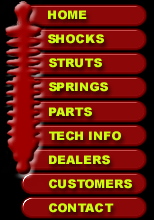|
 MENU MENU |
|
|

SANTHUFF'S
Suspension Specialties
12886 County Road 1394
Sinton, Texas 78387
361-364-3169
|
|
|
|
|
|
 STRUT TECHNICAL INFORMATION STRUT TECHNICAL INFORMATION
|
| | 

Home > Technical Information > Strut Adjustment
Strut Adjustment Procedure  Printer Friendly Version Printer Friendly Version
- Set strut in vertical position
- Turn top adjustable 3/8" hex nut clockwise until nut stops.
- Turn top adjustable nut counter-clockwise 3 turns.
- If double adjustable, turn lower bump adjuster hex knob fully clockwise. Then turn out counter-clockwise 10 clicks.*
- Stroke strut 5 or 6 times to prime the valving and avoid cavitation (After laying horizontal the fluid is displaced).
- Turn top adjustable nut fully clockwise until nut stops again. At that position the strut shock is at it's full firm rebound (extension) position.
- Turn lower bump adjuster hex knob clockwise until it stops to bring it back to the full firm (compression) position.
- The strut is at it's softest position on extension when the top adjustable nut is turned 3 1/4 turns counterclockwise. O-ring damage could occur if turned any more than 3 1/4 turns.
- The strut is at it's softest on the bump (compression) when the adjuster hex knob is turned counter-clockwise until it stops.**
Baseline Setting for Struts
- As a starting point, you need to find what setting it takes to pull the front tires off the ground for a given tune.
- When more power is put to the chassis, the front end will want to rise more and front suspension will have to be tighter. Adjust extension by 1/2 flat to 1 flat tighter.
- Heavier front weight percentages and higher gear ratios, (lower numerically) will want a looser front end. Adjust extension looser 1 flat.
- 1/2 flat adjustments are best when extension is in 0-6 flats range.**
The following adjustments are based with all flats or clicks starting from a full tight adjustment (clockwise) position.
Strut Baseline Settings | Cars Horsepower | On Top (extension) | Bottom (compression) |
| | 3000 HP | 5 flats | 12 clicks | | 2750 HP | 5.5 flats | 10 clicks | | 2500 HP | 6 flats | 10 clicks | | 2250 HP | 6.5 flats | 10 clicks | | 2000 HP | 7 flats | 9 clicks | | 1750 HP | 8 flats | 9 clicks | | 1500 HP | 9 flats | 8 clicks | | 1250 HP | 10 flats | 7 clicks | | 1000 HP | 12 flats | 6 clicks | | 750 HP | 15 flats | 6 clicks | | 500 HP | 20 flats | 6 clicks | | 300 HP | 24 flats | 5 clicks |
*If trying to delay return of front weight transfer start at 6 clicks from full tight. 6 or 7 clicks is also a good tight adjustment to use for a car that wheelstands violently and may help save your headers.
|
|
| | | |
|